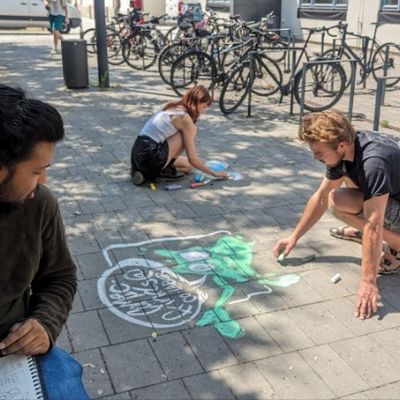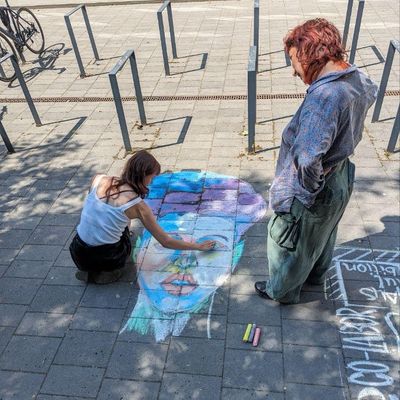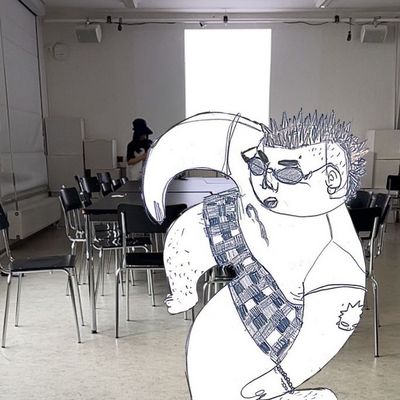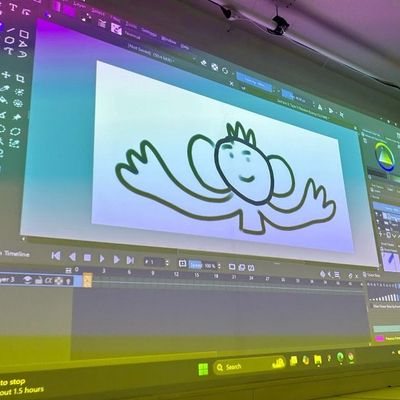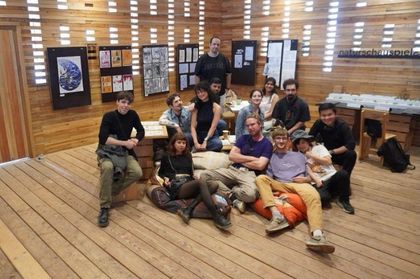Introspection: Mastering Composition Through Comics
Channeling the interdisciplinary in us
The following autobiographical article details my journey teaching the “Komposition durch Comic meistern: Umdenken des visuellen Diskurses über räumliche und soziale Positionierung" Bauhaus-Module in the summer semester 2025.
It was my first time co-teaching or teaching a course related to my major, Human-Computer Interaction. Interestingly, my major combines fields of art, design, technology, psychology, and system engineering into one. With this course, I had an opportunity to hone in on art, comics, and technology, Augmented Reality and animation.
The journey of how I ended up teaching this course with my colleagues Yuen and Huseyn started in the summer semester last year, when I was taking a Bauhaus.Module taught by Yuen. It was also based on comics but focused more on how comics influenced and shaped media industries in East Asia. It all began with my letter of motivation to join Yuen’s course, where I confessed that I was (and still am) an avid comic book reader. I have read comics from all corners of the world, but mainly from the USA, India, and East Asia (Japan, South Korea, China). More than the medium, I love knowing new stories and hence, the art of storytelling, no matter the method, inspires me and invigorates my creativity.
Yuen taught me a lot: creating comics from scratch, the technical aspects of comic creation, panelling, methods to draw attention to characters, and dialogues…it was transformative. Needless to say, when she asked me if I was willing to teach a course with her this summer semester, I was thrilled to be on board.
Teaching a course is not child’s play. I learned this early on, even though I had Huseyn teaching the majority of the classes. Planning which tools to teach the students and how to mould the lectures for the existing students based on their ongoing projects was challenging but not unenjoyable. It was an experience that I would like to go through again if given an opportunity. More than that, it was a privilege to see such passion in the students who were much, much more artistically driven than I was. One of the best parts of Bauhaus.Modules is interacting with students from different majors, something I wouldn’t get to do in my own courses. It is fascinating that we can learn so much from others not working in our field, as a Human-Computer Interaction major, the things you learn will definitely help you cook up ideas or solutions for problem areas you didn’t think of before, especially when it comes to usability and experience design. A change of perspective is not only refreshing but also sparks inner inspiration. The other great thing about being able to shape the way we taught this course was that it felt like a shared space, there was no hierarchy, just a flow of ideas between us and the students. Everyone could contribute, and that made the course feel alive. The students even came up with their own events, like a spontaneous spray-painting session where they invited everyone from our class to join in. On my side, I was running an independent research project where we transformed common surveys into comics, and I invited students from the class to be part of my artist team. We even had students advertise our ComixLab (Summaery exhibit at Co-Labor) with chalk art in the M18 garden, it was fun, collaborative energy that went beyond the classroom.
I was mainly responsible for looking after the technical tool introduction to students during the course, as Huseyn was going to help them with practising their storyboarding, building atmosphere and emotion through their drawing, and building personal narratives. We also had a guest lecture session by Jens Harder, and we discussed his works in my session before his arrival the following week. I think this was a great way to build curiosity about the artist and inspire questions in their minds about his approach to art, his projects, and everything else in between. I introduced two tools as a potential medium for the students to adapt their comic projects to for the Summaery. They were Styly and Krita. Styly is an AR social media app with room to manipulate 2D art and assets into a 3D environment. It lets you place 3D models, images, and animations in real-world spaces, no coding needed. While Krita is a free, open-source tool for creating comics, illustrations, and image edits. It supports both static artwork and frame-by-frame animation. To teach the students about these tools, I categorised the methods we could incorporate comics and augmentation together into three forms.
To explain those methods further, I used sample AR effects that I created using the students’ submissions on our Moodle:
Effect 1: Artificial Environment Element + Comic Element
Superimposing a 2D/3D comic art (drawn on paper or sketched digitally) in a virtually projected environment.
Effect 2: Animated Comic Element + Real Environment (No Artificial Environment Element)
Augmenting an environment or scene with a 2D/3D animation or gif.
Effect 3: Comic Element + Comic Environment Element
Taking a 2D/3D comic art and superimposing it into a real environment which has the physical comic panels laid out. The idea was to complete a physical setup of a comic panel by adding comic characters or elements digitally.
The plan earlier was to also go over another tool, Twine, which is an open-source tool for telling interactive, nonlinear stories. But unfortunately, I had to focus instead on only Krita and mainly Styly, as that took a major chunk of the time during the actual lecture and workshop. I also had to leave some room for troubleshooting in case someone tried adding AR in their projects. We also discussed our Summaery location, Co-Labor near the Ilm Park. One of the students, Milad, chose to have multiple endings for his comic story during Summaery, which was fun to read and surprised me with its approach. Interacting with the students, whether they stayed until the end or not, was just as fun as teaching them. Each one was seriously talented and passionate about comic making. Being able to teach these classes was a great opportunity for me to sharpen my own creative thinking, learn from the students as much as I taught them, and, yes, be a part of something amazing.
This article was created as an introspection of one of the module's student teachers.
Title: Komposition durch Comic meistern: Umdenken des visuellen Diskurses über räumliche und soziale Positionierung
Lecturers: Hüseyn Hüseynbayli (stud. Ma AU), Yuen Yi Wong (stud. Ma AU), Shriya Singh (stud. Ma M)
Mentoring: Prof. Jakob Hüfner (KG)
Semester: Summer semester 2025

